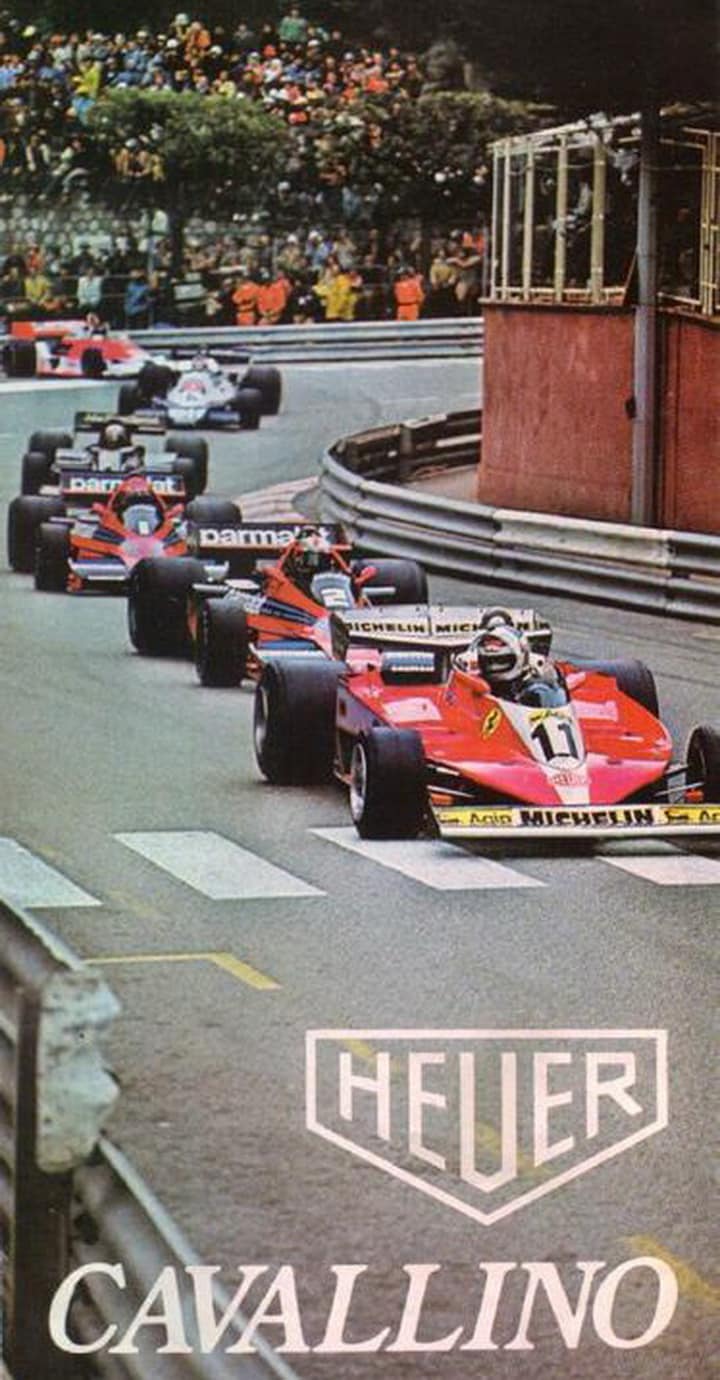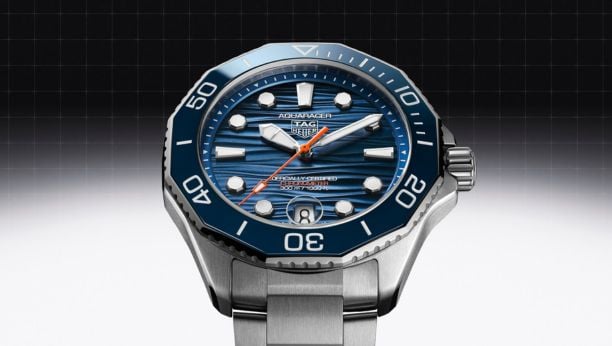VINTAGE COLLECTION
HEUER MONZA
The Monza collection was launched in 1976, to celebrate the historic accomplishment of Ferrari winning the constructors and driver’s Formula One championships, for the first time since 1964. The Monza marked Heuer’s first use of a black-coated case, so in addition to proving to be a popular model offered in a variety of configurations, the Monza paved the way for Heuer to introduce other black coated models in the late 1970s and early 1980s – including Carrera, Montreal and Monaco models. With its black-coated case and the use of black, red and luminous paint on the dial, the Monza captured the racing spirit of the legendary track that gave the model its name and where Heuer would celebrate its triumphant partnership with the Ferrari racing team.


March 1969 would mark some important “firsts” for the Heuer brand. On March 3rd, 1969, at press conferences held in Geneva and New York City, Heuer would introduce the world’s first automatic chronographs, Autavia, Carrera and Monaco models with the name “Chronomatic” printed on the dials. As part of the marketing campaign for these new chronographs, Jack Heuer introduced another innovation for the Swiss watch industry. At the South African Grand Prix, held on Sunday, March 1, 1969, the Lotus 49 driven by Swiss racer Jo Siffert had the Heuer logo on his car, the first appearance of a decal of a non-automotive brand on a Formula One car.
Siffert finished 9th in the championship for 1969, but scored no points in the 1970 season, driving for the March team. It appears that Jack Heuer was pleased with the concept of sponsoring a Formula One racer, but by 1971 he had decided that Heuer should move up-market with its sponsorship effort, which convenient aligned with Ferrari looking to find a partner for their professional timing needs.
The partnership between Heuer and Ferrari would be considerably deeper that simply placing the Heuer decal on the side of a car or on the uniform of a driver. Heuer had developed the “Centigraph”, an electronic timer that could record the times of multiple cars with great precision, but the timing system was expensive, with Heuer offering the system to Ferrari for CHF 35,000. The Centigraph would be at the heart of the multi-faceted exchange between Ferrari and Heuer: Heuer would supply the Ferrari team with the Centigraph system, pay each driver a fee of CHF 25,000 for the season and present each driver with an 18 karat gold Carrera chronograph, and in exchange each of the Ferrari Formula One cars would carry the Heuer logo and each of the drivers would wear the distinctive red patch on his racing suit.
Ferrari had enjoyed its last constructors championship in 1964, and the 1971 through 1974 seasons would see Ferrari finishing in positions between second and sixth, with each constructors championship going to a team (Lotus, McLaren and Tyrrell) using the Ford Cosworth engine.
The 1975 season would mark the return to glory for the Ferrari Formula One team. Austrian Niki Lauda had joined the team for the 1974 season, winning two races, and in the third race of the 1975 season the Ferrari team rolled out its new 312T car. Designed by Mauro Forghieri, the 312T would dominate the Formula One field, with Lauda winning five of the last 10 races and Regazzoni adding a win and two third place finishes over this span. Ferrari won the constructors championship by a wide margin, over the Brabham and McLaren teams, and Niki Lauda clinched the driver’s championship in the penultimate race of the season, with his third place finish at the Italian Grand Prix, at Monza.
For Heuer, Ferrari winning the driver’s and constructors championships represented more than the success of a financial sponsorship. Heuer was very much a part of the team, having developed the timing equipment that gave the Ferrari team an advantage, on the test track and in the races. Heuer would celebrate this partnership in a special way – with the creation of an entirely new chronograph, the Monza. Ferrari and Lauda won their Formula One championships in Fall 1975, and the new Heuer Monza would be introduced in 1976.

With the new Monza chronograph, Heuer offered a model that captured one of the popular trends in chronographs during the mid-1970s – black-coated cases that combined the style of instruments on the dashboard of a racecar with the tactical style of military gear. The case of the new Monza incorporated the geometry of the first automatic Carreras, introduced in 1969, but the new case used a black-chromium coating on a base metal case. Consistent with the utilitarian look of the era, the Monza used a matte black dial with black registers, a dramatic shift from the metallic silver and gray-blue dials of the earlier Carreras, with their contrasting registers.
On all versions of the Monza, the hours are shown with luminous markers, the chronograph minute recorder has red “racing” stripes to mark five-minute increments, and the black inner bezel is marked with both a tachymeter scale (60 to 220 unites per hour) and a pulsations scale (60 to 200 beats per minute, based on a count of 15 pulsations). Hands are painted bright white, with black toward the center pinion.
The first Monza chronographs were powered by Heuer’s Calibre 15 movement -- the economy version of the Calibre 12. The Calibre 15 movement featured running seconds at the 10 o’clock position and a 30-minute chronograph recorder at 3 o’clock, with the hour recorder being deleted. The Monza is one of the few 1970s Heuers to have its model name engraved on the caseback.
Using a base metal case in place of stainless steel and the Calibre 15 movement in place of the Calibre 12, the Monza was positioned as an “economy” model, and Heuer’s 1977 catalog lists it with a price of $219, compared with the Carrera, Jarama and Cortina models, which were in the $345 to $365 range.


THE HEUER MONZA RANGE
The first two models of the Monza both featured the Calibre 15 movement, with the more common model using a black coated case (150.501), with Heuer also offering a model (150.511) with a chrome-coated case. All other elements of the two models are identical, with both of them using a brass case.
CALIBRE 12 MONZA – REFERENCE 110.501
The 1978 catalog shows that with the initial popularity of the Calibre 15 “economy” models, Heuer introduced models that used the Calibre 12 movement, with these also available in black-coated or chromo-coated cases. On these Calibre 12 models, the 12 hour chronographs recorder at 9 o’clock replaces the running seconds hand.

THE NON-NAME MONZA
Heuer’s 1981 catalog includes two versions of the Calibre 12 Monza – one in a black-coated case and one in a chrome-coated case – with one significant difference from the previous models. The name “Monza” has been deleted from the dial, with all other features of the new model being identical to the previous models, except that the dial of the new model adds tiny red hash marks inside the luminous hour markers.


Heuer’s 1977 catalog for Germany shows a model that appears to be identical to the Monza in all respects, except that the name “Monza” is replaced by the name “Modena”. The Modena model was relatively rare, being offered only in certain European markets. Whatever the reason for Heuer’s use of the Modena name, it does capture the romance of Italian sports cars of the 1970s, with the factories of Ferrari, Lamborghini and Maserati being located near the city of Modena.
RACING MATE MONZA
Heuer produced a version of the black-coated Calibre 15 Monza with the “Racing Mate” logo printed across the bottom of the dial. Racing Mate was a Japanese racing accessories company, which sponsored domestic Japanese racing teams in the 1970s.








